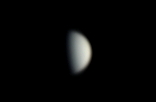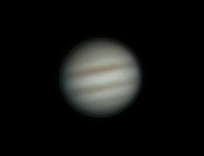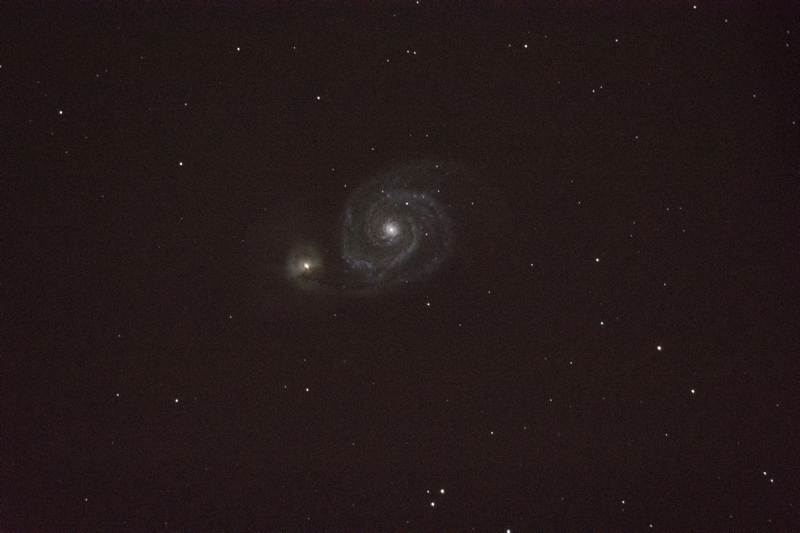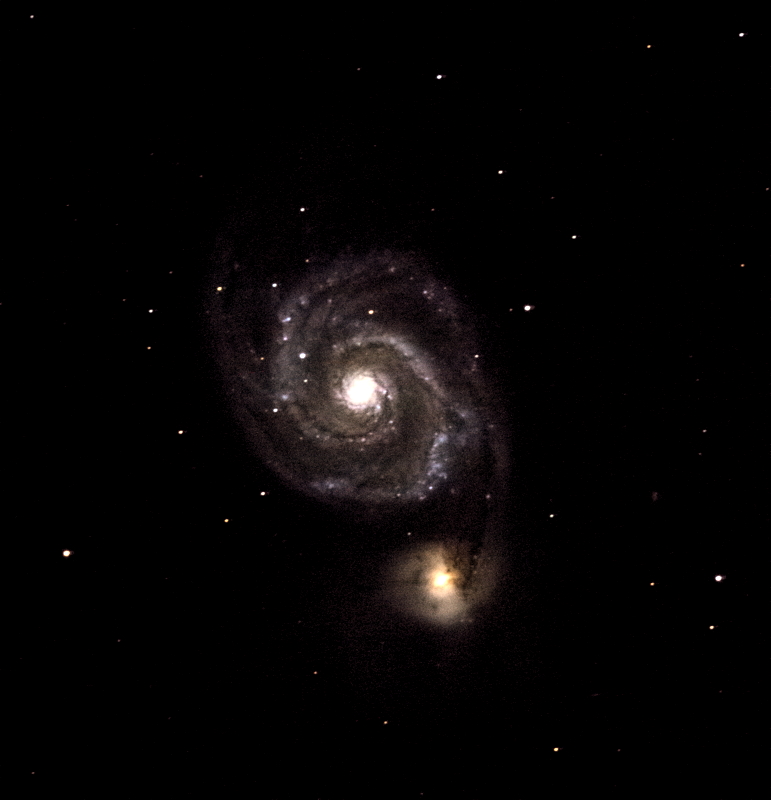D7200 DSLR Imaging: Venus, Mercury, Jupiter,
M51 Whirlpool Galaxy
Posted: 17 May 2015
Cloudy skies returned on Tuesday, 12 May 2015. As sunset approached on Friday, 15 May, this rainbow briefly appeared on one of my webcams:

The rain was only 0.03" that day, but another 0.23" fell Saturday morning, 16 May. The sky began clearing later in the day.
|
Open: Saturday, 16 May 2015, 1821 MST Temperature: 73°F |
Session: 820 Conditions: Mostly clear, some clouds low in west |
1829 MST: viewed Venus, 83X. Switched to the Baader 8-24mm Zoom Eyepiece and viewed Venus. Nice view at 250X (FL 8mm). 1833 MST: slewed to Mercury. It was a faintly visible crescent with low contrast against the still bright sky 47 minutes before sunset. Began setting up for D7200 DSLR imaging of Venus. Mounted the camera at prime focus + 2X PowerMate and did HD video recordings, 1.3X crop factor, 60 frames per second, ISO 200, using various shutter speeds. This is a stack of 942 frames (15 seconds of video; Keith's Image Stacker) at 1/500sec:

1851 MST: began trying for Mercury but it was not visible in the camera or 7x50 finderscope. Began monitoring to see if the planet would become visible before it reached the tree to the west of the observatory. 1920 MST: sunset. The clouds in the western sky were getting closer. 1938 MST: picked up Mercury in the finderscope, very low in the sky and almost into the tree. Grabbed two videos. This is a stack of 942 frames, 1/60sec, ISO 5000:

Then slewed to Jupiter and began video recording. This is a stack of 942 frames, 1/125sec, ISO 1000:

Three of the four Galilean Moons were visible, as seen in this composite image, 1/2sec, ISO 400, and 1/160sec, ISO 1600:

The moons are (left-to-right): Callisto, Europa, and Io.
1954 MST: ended planet imaging. Removed the camera from the 8" LX200-ACF telescope. Viewed Jupiter with the zoom eyepiece + 2X PowerMate. The view of the planet was surprisingly good at 500X (FL 8mm + 2X). Best view was without the PowerMate using 167X (FL 12mm).
2000 MST: the clouds in the west were now about 30° high. Ended Jupiter observing. Switched back to the 2" 24mm UWA eyepiece and slewed to M104 (Sombrero Galaxy), which was to be an imaging target for the night. The galaxy was faintly visible 43 minutes before the end of Astronomical Twilight. Then slewed to M51 (Whirlpool Galaxy), which would be the first DSO target for the night. It was also faintly visible against the still bright sky. Some clouds had now appeared in the northern sky, and clouds were also near M104 in the southeastern sky. Began preparing for DSO imaging. Mounted the DSLR at prime focus + extension + off-axis guider and slewed to the star Arcturus (my focus star using a Bahtinov Mask). Did the focus test at 2038 MST and then slewed to M51.
I began searching for a guide star but found none. Did a 1 minute, ISO 12800, unguided exposure of M51. This is an unedited full-frame image:

I tried a 2 minute, unguided exposure, but it trailed. Did 14 more unguided 1 minute, ISO 12800, exposures. Of the 15 1-minute exposures, 13 were good. I stacked them using Lynkeos, resulting in this effective 13 minute exposure of M51 (Whirlpool Galaxy):

2113 MST: ended M51 imaging. Began the telescope slewing to M104 (Sombrero Galaxy) and rotated the dome to view the southern sky. Oops, the southern half of the sky was cloudy. Decided to close up for the night.
|
Close: Saturday, 16 May 2015, 2133 MST Temperature: 52°F |
|
Comments are welcome using Email. If you are on Twitter you can use the button below to tweet this report to your followers. Thanks.
Cassiopeia Observatory Home Page
Copyright ©2015 Michael L. Weasner / mweasner@me.com
URL = http://www.weasner.com/co/Reports/2015/05/17/index.html
